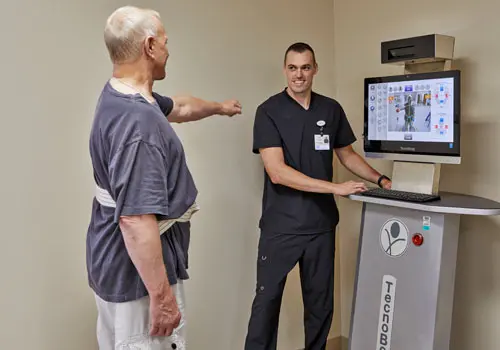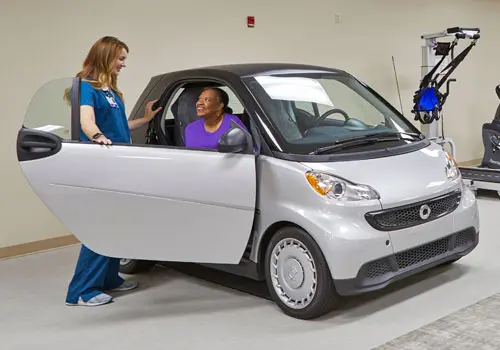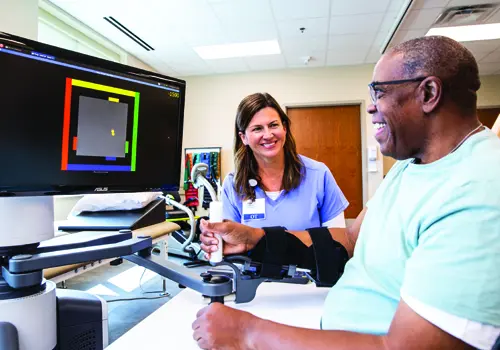Therapeutic Technology
Our hospital provides such leading-edge technology – as well as therapists trained to use it best – to ensure our patients are positioned to recover as quickly as possible.
Innovative Solutions for Superior Outcomes
New technology continues to push the boundaries of what once was considered full recovery from certain injuries or conditions. Today, for instance, top inpatient rehabilitation facilities deploy robotic tools that give stroke patients the ability to use their upper extremities again or help spinal cord injury patients with early ambulation.
Our hospital provides such leading-edge technology – as well as therapists trained to use it best – to ensure our patients are positioned to recover as quickly as possible.
Here are some examples of some of the industry’s best technology deployed at our hospital:
TecnoBody® Isofree
The TecnoBody® Isofree system was designed to treat anyone looking to improve balance, stability, and functional mobility. It addresses a wide variety of pathologies and is a good tool to use in conjunction with traditional therapeutic interventions. TecnoBody Isofree allows for enhancing kinesthetic and proprioceptive awareness during functional tasks as well as working on improving reflex mechanisms that play a role in maintaining balance and decreasing the risk of falls. All of this is facilitated via biofeedback that is provided throughout the activity by the interconnected sensor platform and 3D camera.

Smart Car
Our Smart Car is fully integrated into our rehab gym, allowing our patients to learn and practice car transfer skills year-round at any time during a treatment session. Car transfer training activities are essential to prepare our patients for community reintegration and setting them up for success when getting back to their daily activities.

SaeboMAS
The SaeboMAS is a zero-gravity upper extremity device used to facilitate or challenge the weakened shoulder during functional tasks, such as eating or combing your hair. This device is used with patients with neurological and orthopedic conditions resulting in shoulder weakness. The adjustable spring-based tension system offers variable levels of assistance as the patient’s strength improves and makes it easy to track and document progress. It can be used to increase strength, range of motion, and motor control and encourage neuroplasticity by allowing the opportunity for highly repetitive tasks.
InMotion
The BIONIK InMotionARM™ Robot is often used with many patients who suffer from weakness in their upper extremities after a stroke. The ARM Robot helps patients utilize their strength to complete hundreds of repetitions in a fraction of the time of traditional exercise. Repetition is one of the most important factors when considering neuroplasticity and the brain’s ability to repair and relearn movements following a stroke. This evidence-based neurorehabilitation technology quietly monitors the patient’s movements during therapy while gently assisting where needed to help them complete various motor therapy activities.

LSVT® BIG and LOUD Therapy
Now providing treatment for Parkinson’s disease and other neurological conditions.
Lee Silverman Voice Treatment (LSVT®) Big and Loud Therapy to empower those living with Parkinson's disease to move and speak better. Declining vocal strength, muffled speech and difficulty swallowing create problems with communication and eating. Patients also often experience tremors, slow movement, impaired balance and stiffness. But there is good news – studies have proven patients with Parkinson's disease at any stage can benefit from intensive rehabilitation.
- LSVT® can help people with other conditions such as stroke, multiple sclerosis, multiple systems atrophy, cerebral palsy.
- LSVT® Big and Loud is especially effective soon after the disease is diagnosed.
SPEAK LOUD – MOVE BIG: LSVT® is an effective treatment program that's proven to help individuals living with Parkinson's disease, giving them new hope for improved communication and movement for work, family and social activities. The method was developed following rigorous research funded by the National Institutes of Health.
LSVT BIG™: Physical therapists or occupational therapists use LSVT Big to address the unique movement impairments for people with Parkinson's disease. Therapists work with individuals to improve major motor skills, like walking, arm and leg movement, balance, and hand skills such as writing.
LSVT LOUD™: Speech-language pathologists improve vocal loudness by stimulating the muscles of the voice box (larynx) and speech mechanism through a series of loud exercises. Therapy does not train people to shout or yell – rather it trains a healthy louder voice with no strain.
Bioness® L300 Plus
An electrical stimulation machine that activates thigh and lower leg muscles to assist with control and stability during ambulation and functional tasks.
- Helps with controlling the knee and assisting with foot drop
- Research has proven it is very effective in improving walking speed and symmetry. It has reduced the step inequality by 25% during the first walk and continues to show improvement even after six weeks
- It is effective with MS, CVA, and other conditions where the motor unit is intact
Bioness Integrated Therapy System
The Bioness Integrated Therapy System (BITS) is a software program that can aid in the therapeutic process for individuals with traumatic injuries, movement disabilities, and executive function disorders. The interactive touch-screen therapy device improves hand-eye coordination, reaction time, depth perception, and working memory in patients with a variety of neurological conditions. By playing interactive games and taking assessments, patients can improve their coordination and brain function in an engaging, fun way.
The software program runs on a large flat touch screen, allowing the patient to participate in a more dynamic way than traditional therapies. It allows the patient to work on divided attention activities, combining gross motor activities and cognitive challenges to better simulate our daily lives for improved functional outcomes.

Bioness L300 Go Lower Cuff
The Bioness L300 is a medical device that uses state-of-the-art, functional electrical stimulation technology to help improve safety and efficiency for people with foot drop, an abnormal walking pattern caused by a broad range of conditions, including stroke, traumatic brain injury, multiple sclerosis, cerebral palsy, and incomplete spinal cord injury.
The L300 System stimulates the nerves in the lower leg, activating muscles to lift the foot. This allows you to walk more naturally, enjoy greater independence, and improve your quality of life. This discreet device is worn on the lower leg and operated by a wireless handheld remote control. This technology allows the physical or occupational therapist to fine-tune settings while the patient is actually walking. The system’s gait-sensing technology automatically detects foot position, walking speed, and changes in terrain.
Bioness® H200 Wireless Hand Rehabilitation System
The H200 is used to stimulate nerves and muscles of the forearm and hand in order to regain hand function in order to increase independence with activities of daily living.
Specific goals include:
- Increase hand function
- Increase or maintain hand range of motion
- Reduce muscle spasms
- Prevent muscle loss
- Reeducate muscles
- Increase blood circulation
The Korebalance Premiere-22
Korebalance is a balance training system incorporating Variable Speed Reaction (VSR) training and cognitive interaction. It challenges a patient’s balance through various velocities, angles, and directions, demanding cognitive, visual, vestibular, and proprioceptive engagement. This high-quality therapy allows healthcare professionals to customize the program and adjust difficulty levels and tasks over time. By challenging these systems simultaneously via repetitive actions, the body is required to make balance corrections automatically.
Vestibular Rehabilitation Therapy
Vestibular rehabilitation therapy (VRT) is a specialized form of therapy intended to alleviate both the primary and secondary problems due to vestibular disorders. It is an exercise-based program primarily designed to reduce vertigo and dizziness, reduce gaze instability, and/or reduce imbalance and fall risk as well as address any secondary impairments resulting from the vestibular disorder. A customized exercise plan is developed from the clinical assessment findings, laboratory testing and imaging studies, and patient input. Different factors can impact the potential for recovery, including activity level, pain, other medical conditions, medications, and emotional concerns.

.png?%2fimages%2firflongviewrehabilitationhospitallibraries%2fdefault-album%2fbestofetx_2023-(002).png)
